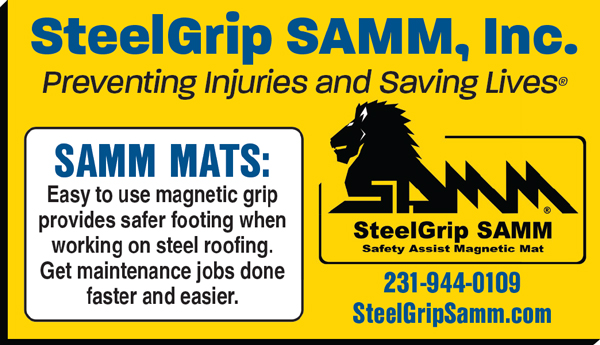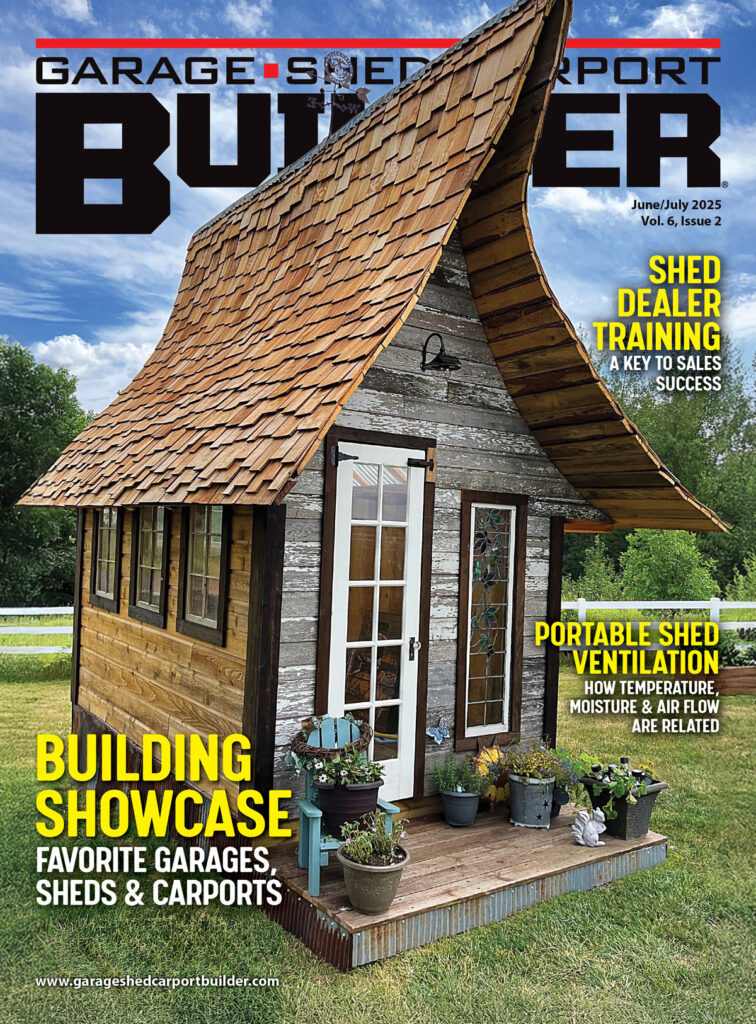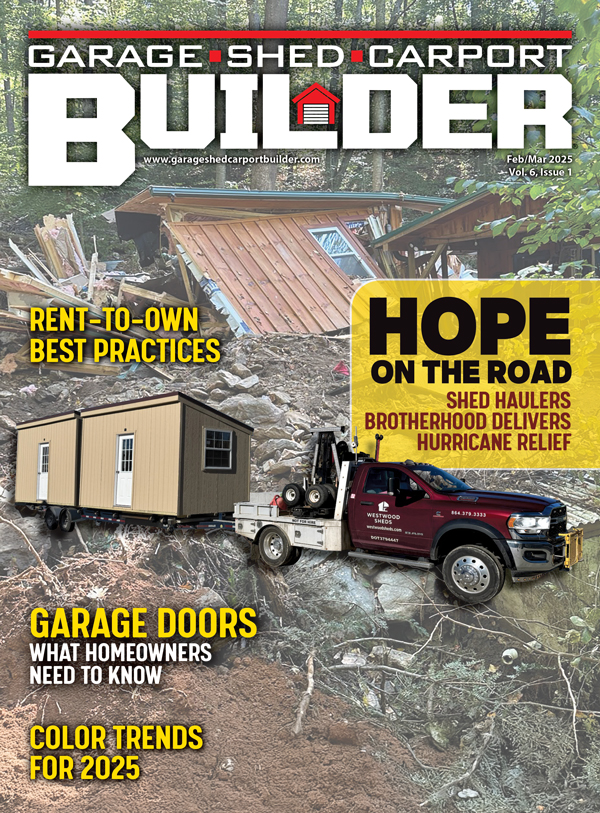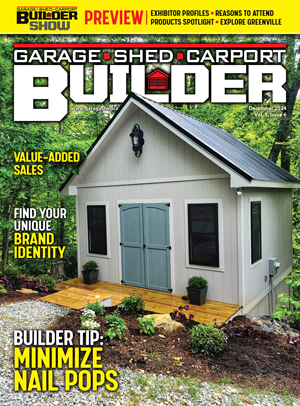By Shannon Latham
To begin this column, I must first establish a foundation. Just as a shed typically begins on a set of notched runners and builds upward, we need to structure our thinking about this topic. We will approach this by taking a 30,000-foot view of the shed industry while hopping onto and out of some rabbit trails.
The shed industry is diverse, with various approaches to being a shed dealer. As someone who travels the country visiting shed manufacturers, dealers, and other shed-related entities, it has become apparent to me how fragmented our industry is. I view shed dealerships in different categories, making it easier to understand the landscape.
Consignment Dealers
Consignment dealers work similarly to traditional floor planning of inventory. Many shed dealers operate under this model, especially in the Midwest and scattered throughout other states. These dealers may be part of a larger corporation with shed manufacturing centers strategically placed for regional growth. Some manufacturing locations are company-owned, while others are independent contractors exclusively focused on manufacturing.
Companies often invite dealers to become affiliates by offering a specific shed brand. They typically provide inventory, often from 20 to 30 sheds, at zero cost to the dealer. Additionally, these companies offer delivery services, office space, website design, marketing support, training, and customer service.
Company-Operated Shed Lots
Company-operated shed lots are run by the parent company, with an employee present on site. The parent company bears all expenses, such as lot rent and overheads, in exchange for a negotiable sales commission or salary. Shed companies of various sizes use this model, aiming to expand regionally through vertical integration.
Wholesale Dealers
Wholesale shed dealers, more common in the Northeast, purchase inventory directly from shed manufacturers. They have ownership of their location, offering more flexibility but also higher risk.
Wholesale dealers purchase inventory, allowing them to operate within profitable margins, potentially leading to higher financial rewards. They often own shed-hauling equipment, providing control over the delivery process. Additionally, they may collaborate with other dealers when using third-party vendors for shed delivery services.
These are just a few examples of shed dealership models, with many other variations and nuances to explore. While we could delve deeper into each business model in separate articles, the focus here is on establishing foundational thinking and transitioning into how to find a shed dealer and all the associated details.
When I first began my own shed journey over 10 years ago, I was hired as a procurement coordinator for a rather large shed company. It had 13 manufacturing locations, primarily south of the Mason-Dixon line with various shed lots.
After a hiatus to work in faith-based drug and alcohol rehabilitation, I transitioned into shed sales. This journey led me to own three different locations in three different states, and eventually to owning a shed hauling setup with two partners.
I then moved into a role as a sales manager and eventually as an RTO representative before venturing into the Shed Geek Podcast. Drawing on my experience as a sales manager, I help navigate the complexities of opening shed lots.
Though we were not a large company, I have found that the pain points and considerations we faced are still relevant for sales managers and shed manufacturers today. Hence, I compiled a list of five things to consider as you expand your dealer network.

Photo courtesy of David Seidl, www.customshedsonhwy10.com.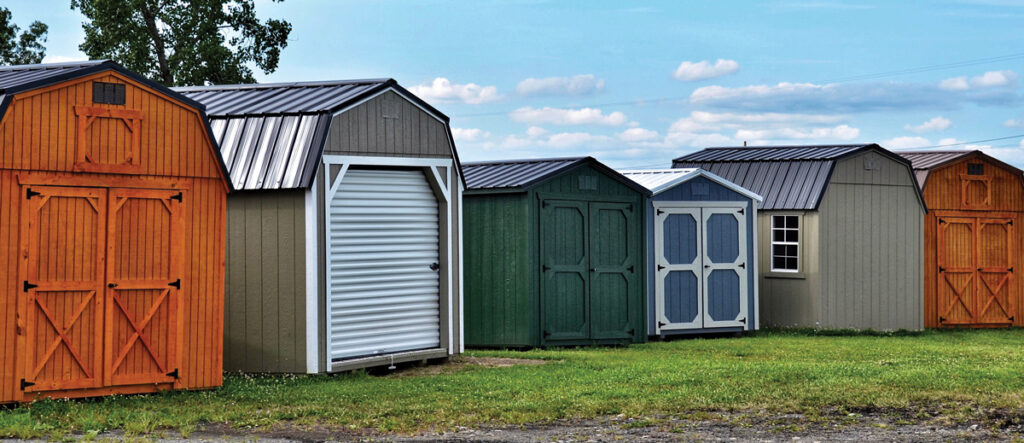
1. Location Selection
Choosing a prime location that is easily accessible to your target customers and has high visibility to attract foot traffic is foundational for your shed retail business. Check local zoning regulations and restrictions to ensure that the location allows for commercial retail operations, especially for selling sheds. Compliance with zoning laws is crucial to avoid legal issues in the future.
Additionally, conduct a demographics analysis by researching the area’s demographics to help you understand the potential customer base. Consider factors such as income levels, age groups, and lifestyle preferences to tailor your shed offerings accordingly.
Moreover, pay close attention to the accessibility and visibility of the location. Ensure it is easily reachable by both car and foot traffic, as this will attract more customers.
Evaluate foot traffic and ensure ample parking facilities to enhance accessibility and convenience for potential customers. Remember that a comfortable customer experience is key, so factor in real estate costs — including rental or purchase price, utilities, and maintenance — to ensure the location fits your budget.
Engaging with the local community is essential for establishing a positive reputation and attracting customers through referrals. Building relationships with neighboring businesses, residents, and authorities can significantly benefit your business.
Consider choosing a location with a scenic or natural setting that complements the appeal of the sheds you are selling, enhancing the aesthetic appeal and drawing customers who are seeking an outdoor shopping experience.
Shed display is crucial; make sure they are organized and efficiently presented. Remember that choosing the right location is critical and can significantly impact the success of your shed retail business.
Conduct thorough research, analyze relevant factors, and prioritize finding a location that aligns with your target market and business goals.
Pro Tip
For those in Illinois, a useful internet resource to view the annual average daily traffic count is gettingaroundillinois.com. Once on the site, simply navigate to the Annual Average Daily Traffic tab, input the address of the potential shed location, and check the average car count on that or any particular road. If you are a brick-and-mortar location with no digital storefront, this is one way to measure the number of potential walk-ins to your store.
2. Inventory Planning
If you are new to an area where you are opening a shed lot, you may not have much information to help with inventory planning. Whether you are opening a consignment location as a new dealer or as a sales manager/manufacturer, there are several tools you can use for effective inventory planning.
If your company uses any shed point-of-sale software with reporting capabilities, consider filtering a search for the most common shed styles, sizes, and colors sold in nearby areas. This can give you an idea of what sheds might be most desirable.
If you are starting from scratch, conducting a competitor analysis is a sensible first step. Examine the types of sheds your competitors are offering and their sales trends. Identify any gaps or niches that you can fill more effectively.
Another consideration is the climate in the area where your shed lot will be located. In regions prone to harsh weather, stock sheds are built to withstand these conditions. For example, opt for heavier trusses in areas with significant snowfall and pay attention to ventilation or insulation in hotter or colder areas.
Zoning regulations are another important factor. Dealing with different municipalities can be daunting, especially within city limits. Understand local zoning laws and how they will affect the amount of inventory you can display.
Familiarize yourself with building codes to ensure that all sheds comply with local requirements, making your offerings more attractive to customers. Homeowner associations may have specific style or size restrictions that also need to be considered when selecting your inventory.
Build consumer confidence by having information about zoning laws or points of contact available during the sales process to help overcome objections. In addition to offering a variety of sizes to meet all clients’ needs, consider providing different price points and even financing or rental options. This allows customers to afford the cost of adding a shed to their property.
Effective inventory planning involves a deep understanding of your local market, offering diverse styles and sizes to match various needs and price points, and being responsive to seasonality and emerging trends. By carefully curating your shed inventory based on these principles, you can ensure that your shed lot appeals to a broad customer base and meets local demands, ultimately leading to increased sales and customer satisfaction.w
3. Marketing Strategy for Shed Retail Lots
Develop a comprehensive marketing plan to promote your shed retail lot. Use a mix of online and offline channels, such as social media, local advertising, direct mailers, and collaborations with surrounding businesses, especially home improvement stores. This multifaceted approach will help you reach a broader audience and drive sales effectively.
If you are opening a consignment location, it is common for a shed manufacturer to partner with an existing, established business. Often, it is beneficial to find a complementary business aligned with the products you will be offering.
These can range from farm implement stores and flower shops to car dealerships and mall fronts. Each seeks a competitive advantage, whether it is high traffic or ample unused space where a shed hauler can navigate comfortably.
It is crucial to vet the partnering business thoroughly to ensure it aligns well with your product. Be cautious when implementing floor plans, as priorities might shift if no upfront cost is involved. Additionally, consider either a wholesale approach or invest time in the dealer acquisition phase to understand the business model fully.
Creating a marketing strategy for a brick-and-mortar location will differ from that of a digital storefront. However, both can build brand recognition using social media platforms such as Meta (Facebook and Instagram) and X (formerly Twitter). These platforms allow you to showcase your sheds, engage with customers, and run targeted ads.
Establish a professional website optimized for search engines to ensure visibility on Google by including detailed descriptions, high-quality photos, and customer testimonials. Email marketing can also be highly effective; create an email newsletter to keep potential and existing customers informed about new arrivals, promotions, and events.
Local advertising strategies, such as using local newspapers, magazines, and community bulletin boards, can also yield results. Consider joining local chambers of commerce or networking groups like BNI, sending direct mailers to offer discounts or exclusive invitations, investing in high-quality road-visible signage, and participating in local fairs and home shows.
A referral program to incentivize happy customers can turn them into your best and least expensive sales team. Host grand opening events with special giveaways, plan holiday and seasonal promotions, and offer workshops on relevant topics.
Adjust and assess your strategy regularly to respond to market changes and customer behavior, ensuring a proactive and adaptable approach. Whether brick-and-mortar or digital, a multi-faceted marketing plan that includes both online and offline strategies can effectively promote your shed retail lot. Use these tips to guide your approach and adapt as necessary to ensure continued growth and success in the market.
4. Customer Experience Detailed Breakdown
Creating a superior customer experience is essential for fostering loyalty and encouraging repeat business. To achieve this, you need to focus on several core areas, each with its own set of detailed actions and strategies. One of the chief concerns is that many dealers seem unprepared when it comes to sales training, particularly in the areas of financing and rent-to-own programs.
Leaving that aside for now, let’s look at some areas of focus for a new sales lot owner. Product knowledge is a must. It is essential to develop training modules that cover every aspect of your product lines.
Dealers should understand features, benefits, and common use cases for each product. It is imperative to educate dealers on how the products are made, the materials used, and how these contribute to quality and durability.
Creating a “workshop day,” in which dealers can access interactive training sessions with builders and haulers helps avoid confusion from the point of sale to a delivered shed. For sales managers, implementing role-playing exercises will help sales professionals practice problem-solving scenarios. Even the most engaging speakers practice before the real thing; it may feel odd at first, but the results will be evident.
Ensure training is not a one-time event but rather conducted monthly or even weekly if necessary. Keep dealers informed of new products, industry trends, and market changes. Create a system where staff can share insights and successful tactics with the rest of the team representing your brand.
Be sure to integrate a good customer relationship management (CRM) tool to help track customer interactions and purchase history. Establish a follow-up process where dealers check in with customers after a purchase to ensure satisfaction and address any issues or questions. Customers often need communication; map out the journey from first contact to post-purchase to ensure consistency throughout their buying experience.
For the digital storefront, make sure your website is intuitive and allows customers to easily navigate through products, view detailed descriptions, and make purchases effortlessly. Also, ensure your online platform is optimized for mobile devices, providing a seamless browsing and purchasing experience on all types of screens.
Offer multiple payment options, including traditional methods like credit/debit cards, as well as financing options and rent-to-own programs. Some companies even offer layaway plans and accept cryptocurrencies.
Don’t forget to focus on post-sale support, from being able to answer maintenance service inquiries to warranty or Limited Damage Waivers (LDW) for rent-to-own clients. Collect surveys and reviews to monitor and understand what customers are saying about your products and services.
By addressing each of these areas meticulously, you can deliver an exceptional customer experience that promotes loyalty, repeat business, and long-term success.
5. Selecting and Retaining the Right Sales Representative
Selecting the right sales representative for a shed lot is critically important because the role directly affects customer satisfaction, sales performance, and overall company reputation. Here are a few things to consider as to why these matters and how a good shed seller can significantly impact your business.
First impressions are lasting. I always love to ask shed sellers, “When a customer first makes their way to your lot, do you go out and greet them immediately?” If they say “Yes,” I ask, “Why would you swarm them like that? Doesn’t that make you look desperate? Don’t you think if they have any questions, they’ll ask?”
If they say “No, I like to let them look around and come to me if they have any questions.” I then ask, ”Do you feel that’s appropriate customer service? Did you do all you could?” Don’t worry, I let them off the hook. Most answer the same way every time: “I let them look around a bit, and then I go greet them to make sure they know I’m here to help.” From my experience, this seems to be the most consistent answer.
My point is that first impressions matter, and a good shed seller knows how to balance this interaction. Skilled representatives understand the product inside and out — materials, dimensions, customization options, and use cases — which directly influences the customer’s first impression. A warm and approachable sales rep can make customers feel comfortable and valued, creating a positive first interaction that sets the tone for the entire sales process.
Additionally, a trustworthy sales rep who communicates honestly about features, pricing, and limitations will build trust with the customer. Whatever approach you choose, remember that honesty will win. Honesty reduces the risk of buyer’s remorse and increases the likelihood of repeat business and referrals.
Good reps maintain regular, thoughtful communication with customers, ensuring that post-visit queries and concerns are addressed promptly.
What else makes a good customer service sales rep? Active listening! Skilled sales reps can listen carefully to customers, understand their specific needs, and tailor their pitch to address those needs accordingly. As the saying goes, “Sales is a transfer of enthusiasm.” They will know if you care about the products you sell or not.
Good salespeople don’t just sell; they educate customers about the importance of quality, how to maintain the sheds, and the best ways to use them, adding value to the customer’s purchase. They understand the strategy of upselling — not as a trick but rather to ensure that adequate service has been provided.
Have you ever had anyone come back and say the shed they bought was too big? Me neither. They always say, “You should have sold me something larger; that was what I really needed.”
You need confidence to ask the hard questions, including asking for the sale in general. A good sales rep will know how to overcome stalls and objections, making for the best possible outcome for themselves, the customer, and the company. I have often heard that an A+ salesperson in a D- location can perform better than a salesperson in an A+ location with a D- attitude.
Always keep in mind who is representing your brand of products and proceed with great consideration. Ensure your sales representatives match your values, mission, and the best interests of your company and customers.
In conclusion, selecting the right sales representative for a shed lot is crucial because the role directly affects customer satisfaction, sales performance, and overall company reputation. A careful selection of a skillful shed seller can significantly impact your business positively.
Shannon Latham is a 10-year veteran of the shed industry, dedicated to driving innovation and progress. As the host of the Shed Geek Podcast, he shares valuable insights and fosters a community pushing industry boundaries. With Shed Geek Marketing, Shannon helps shed businesses reach their audience and stand out in a competitive market. Through Shed Geek Rentals, he provides convenient RTO services, catering to the unique needs of shed customers. Shannon’s expertise and commitment make him a valuable resource for shed businesses, helping them thrive. GSCB







